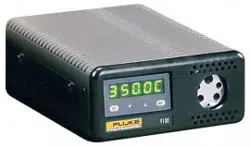Loading ...
Loading ...
Loading ...

35
Test Probe Calibration
Dry-well Characteristics
8 Test Probe Calibration
For optimum accuracy and stability, allow the calibrator to warm up for 10 minutes
after power-up and then allow adequate stabilization time after reaching the set-point
temperature. After completing operation of the calibrator, allow the well to cool by
setting the temperature to 25°C for one-half hour before switching the power off.
8.1 Calibrating a Single Probe
Insert the probe to be calibrated into the well of the instrument. The probe should
t snugly into the calibrator probe sleeve yet should not be so tight that it cannot be
easily removed. Avoid any dirt or grit that may cause the probe to bind in the sleeve.
Best results are obtained with the probe inserted to the full depth of the well. Once the
probe is inserted into the well, allow adequate stabilization time to allow the test probe
temperature to settle as described above. Once the probe has settled to the temperature
of the well, it may be compared to the calibrator display temperature. The display
temperature should be stable to within 0.1°C degree for best results.
CAUTION: Never allow foreign material into the probe holes of the block.
Fluids and other materials can damage the instrument causing binding and
damage to your probe.
8.2 Dry-well Characteristics
There is a temperature gradient vertically in the test well. The heater has been applied
to the block in such a way as to compensate for nominal heat losses out of the top of
the dry-well. However, actual heat losses vary with design of the thermometer probes
inserted into the calibrator and the temperature. For best results, insert probe to full
depth of well.
8.2.1 Stabilization and Accuracy
The stabilization time of the instrument depends on the conditions and temperatures
involved. Typically, the test well stabilizes to 0.1°C within 5 minutes of reaching the
set-point temperature as indicated by the display. Ultimate stability is achieved 10 to
20 minutes after reaching the set temperature.
Inserting a cold probe into a warm well requires another period of stabilizing
depending on the magnitude of the disturbance and the required accuracy. For
example, inserting a 0.25 inch diameter room temperature probe into a sleeve at 300°C
takes 5 minutes to be within 0.3°C of its settled point and might take 10 minutes to
achieve maximum stability.
Speeding up the calibration process can be accomplished by knowing how soon to
make the measurement. It is recommended that typical measurements be made at the
desired temperatures with the desired test probes to establish these times.
1.888.610.7664 sales@GlobalTestSupply.com
Fluke-Direct.com
Loading ...
Loading ...
Loading ...
